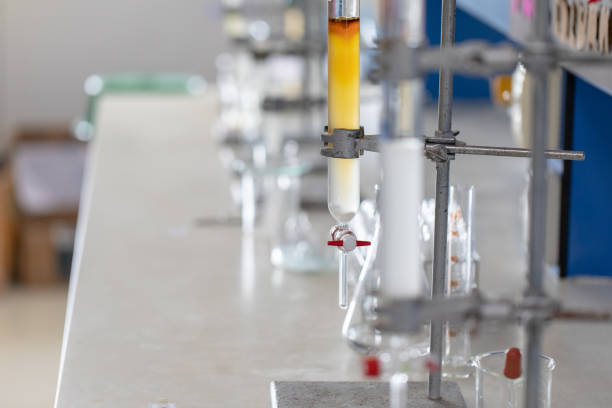Column chromatography is a method used to separate a particular compound from a mixture. It isolates these components by differential adsorption of the compounds to the adsorbent.
This, in turn, helps in the separation of the compounds while they go through a column. This technique gives precise results and is used in various fields like purification of metals, determining the composition of drugs, etc.
Principles of Chromatography
When the mobile phase and the mixture to be separated are applied from the top of the column, individual components of the mixture shift at different speeds. Components with lower adsorption and attraction to the stationary phase travel faster than the others.
The components are eliminated based on how fast they move; the faster ones get discharged first, followed by the slower ones.
Procedure for Chromatography
Let’s go through the various phases involved in the Column Chromatography Process.
The mobile process is made up of solvents and is responsible for the following functions:
- It works as a solvent and helps with adding, in the column, the sample mixture.
- It works as a developing agent, aiding in the isolation of components in a sample into bands.
- It works as an eluting agent, removing the components separated during the process from the column.
Mobile phase solvents include alcohol, isopropyl, water, acetic acid, and other polar solvents.
The stationary phase is a solid material with good adsorption properties and must meet the following requirements:
- Particles should be standardized in shape and scale, ranging from 60 to 200 microns in diameter.
- It should have high mechanical stability and chemical inertness. Also, no acids, bases, or other solvents are used during the process.
- It should be colorless, cheap, and easily accessible.
- It should be possible for the mobile process to flow freely.
- It should be capable of separating mixtures of different compounds.
Applications
- Chromatography is used to extract active ingredients.
- It is extremely useful in the separation of compound mixtures.
- It’s used to figure out how much medication costs based on its composition.
- It’s used to get rid of impurities.
- This process is used to separate metabolites from physiological fluids.
Types
- Adsorption chromatography – It is a separation method in which the components of a mixture are adsorbed on the adsorbent’s surface.
- Partition chromatography – In partition chromatography, both the stationary and mobile phases are liquid.
- Gel chromatography – In this chromatography process, the separation takes place in a gel-filled column. A solvent retained in a solvent gap is referred to as the stationary step.
- Ion exchange chromatography – A chromatography process in which an ion-exchange column replaces the stator.
The process
The stationary phase is rendered wet with the aid of a solvent, so the upper level of the mobile phase and the stationary phase should fit. A solvent or a mixture of solvents makes up the mobile phase, also known as the eluent.
In the first step, the compound mixture to be separated is added to the top of the column without disturbing the top level. The adsorption process on the silica surface starts when the faucet is turned on.
By gently rubbing the glass column’s sides without disturbing it, the stationary phase solvent mixture is slowly added. The solvent is applied as required in the process. The tap is turned on to start the movement of compounds in the mixture.
The polarity of molecules in the sample causes the motion. Compared to the polar components, the non-polar components travel faster. If a compound mixture contains three different compounds, such as red, blue, and green, their polarity order would be: blue>red>green.
The green compound would pass first because its polarity is lower than the others. It is deposited in a clean test tube as it reaches the end of the column. After that, the red compound is extracted, followed by the blue compound. Each of these is collected in its test tube.
Chromatography’s basic concept is to use a stationary phase to adsorb solutes from a solution until separating the mixture into distinct components. The stationary process is less expensive and can be disposed of easily because it is recycled, which is a significant advantage of this chromatography system.
The compound separation is similar to TLC because a mobile phase transports the compound mixture through a stationary phase. The key concept of chromatography is the adsorption of the solution’s solutes using a stationary step, followed by the separation of the mixture into independent components.














Add Comment